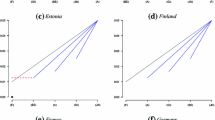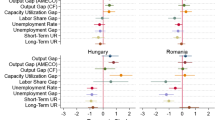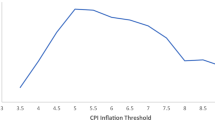Abstract
This paper starts from the observation that inflation in transition economies appears to be persistently high and volatile and attempts to provide some empirical characterisation of the inflation process in three such transition economies: Poland, Hungary and Czech Republic. We first consider the role of monetary growth as a major causal factor for inflation in these economies, and argue that the evidence provides rather weak support for the causal relationship. We then propose a transition economy cost-plus model and estimate this using the equilibrium-correction modelling (ECM) strategy augmented by introduction of a number of transitory factors and changes in the internal structure of the real economy which we believe may have had a significant impact on inflation in these economies. We show that this approach enables us to account for long-run inflation in these economies from the early 1980s to the present despite the turbulence of the latter part of the sample period. Our results support wage and exchange rate based inflation policies.
Similar content being viewed by others
References
Commander, S. and Coricelli, F. (1991), ‘Levels, rates, and sources of inflation in socialist economies: A dynamic framework’, in S. Commander ed. Managing Inflation in Socialist Economies in Transition, World Bank.
Coricelli, F. (1995), ‘The impact of monetary policy on output and prices and the development of domestic financial markets’ Paper presented at the EEA Congress 1–4 September, Prague.
Engle, R. F., Hendry, D. F. and Richard, J.-F. (1983), ‘Exogeneity’, Econometrica, 51, 277–304.
Ericsson, N. R. (1992), ‘Cointegration, exogeneity, and policy analysis: An overview’, Journal of Policy Modelling, 14, 251–80.
Hall, S. G. and Koparanova, M. S. (1995), ‘Modelling and forecasting structural change in transition: The case of Bulgaria’, Discussion Papers 6–95, Centre for Economic Forecasting, London Business School.
Haldrup, N. and Salmon, M. (1993), ‘Polynomially cointegrated systems and their representations: A synthesis’, Discussion Papers 22, Institute of Economics, University of Aarhus.
Hendry, David (1995), Dynamic Econometrics, Oxford University Press.
Hendry, D. F. and Ericsson, N. R. (1991a), ‘An econometric analysis of UK money demand in Monetary Trend in the United States and the United Kingdom by Milton Friedman and Anna J. Schwartz’, American Economic Review, 81, 8–38.
Hendry, D. F. and Ericsson, N. R. (1991b), ‘Modelling the demand for narrow money in the United Kingdom and the United States’, European Economic Review, 35, 833–86.
Heymann, D. and Leijonhufvud, A. (1995), High Inflation, Clarendon Press, Oxford.
Johansen, S. (1988), ‘Statistical analysis of cointegration vectors’, Journal of Economic Dynamics and Control, 12, 231–254.
Kornai, J. (1995), ‘Eliminating the shortage economy: a general analysis and examination of the developments in Hungary’ (in two parts), The Economics of Transition, 3, 13–37, 149–168.
Levine, R. and King, R (1993), ‘Finance, entrepreneurship, and growth: Theory and evidence’ Journal of Monetary Economics, 32, 513–42.
Martin, C. (1996), ‘Price inertia in OECD countries’, Department of Economics Discussion Papers, 350, Queen Mary and Westfield College.
Qin, D. (1994a), ‘Money demand in China: The effect of economic reform’, Journal of Asian Economics, 5, 253–71.
Qin, D. (1994b), ‘Disequilibrium policy effects on money demand relationship: Evidence from three economies’, Department of Economics Discussion Papers, 316, Queen Mary and Westfield College.
Rowlatt, P (1992), Inflation, Chapman Hall.
Sahay, R. and Vegh, C. (1995), ‘Inflation and stabilisation in transition economies: a comparison with market economies’ IMF Working Paper, WP/95/8.
Salmon, M. (1988), ‘Error correction models, cointegration and the internal model principle’ Journal of Economic Dynamics and Control, 12, 523–49.
Author information
Authors and Affiliations
Rights and permissions
About this article
Cite this article
Qin, D., Vanags, A. Modelling the inflation process in transition economies: Empirical comparison of Poland, Hungary and Czech Republic. Econ Plann 29, 147–168 (1996). https://doi.org/10.1007/BF00683946
Issue Date:
DOI: https://doi.org/10.1007/BF00683946




